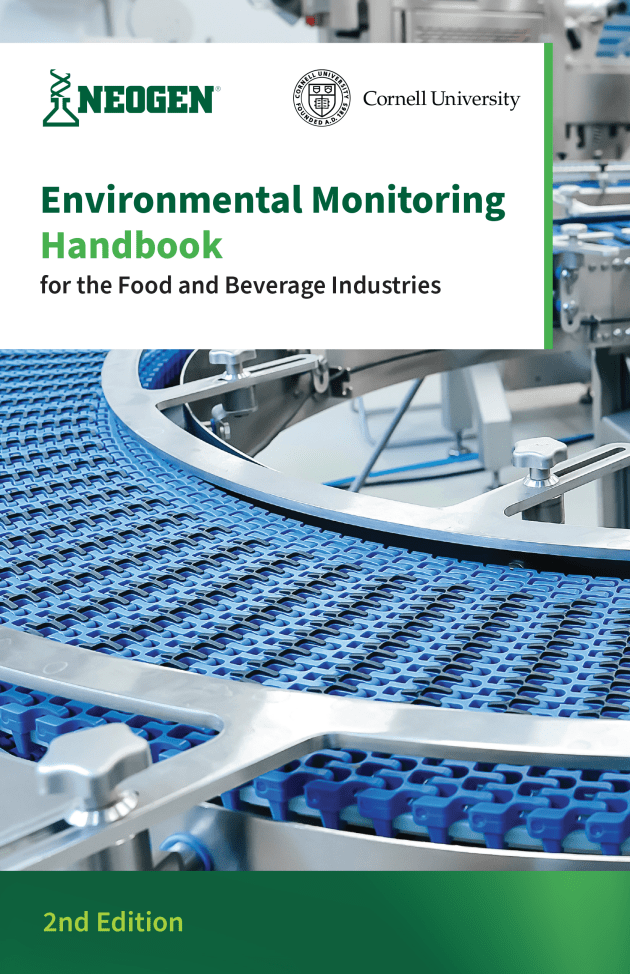Environmental monitoring is a critical component of food safety programs, involving sampling and testing the environment and equipment within a food manufacturing facility to help prevent cross-contamination of finished products. Neogen has released the second edition of its handbook for the sector.
In today's global food supply chain, ensuring the safety and quality of food products is not only a regulatory obligation but a moral imperative. Recent cases of pathogen outbreaks in Australia and around the world continue to serve as warnings for the potential consequences to consumers and producers alike when systems break down.
Safeguarding against microbial contamination
Environmental monitoring programs (EMPs) have emerged as tools for safeguarding against microbial contamination and play a pivotal role in validating cleaning protocols, detecting pathogen harbourage sites, and preventing outbreaks.
At their core, effective environmental monitoring programs serve as an early warning system that can help reduce the risk of recalls, extend product shelf life, streamline production, and increase customer satisfaction.
A trusted resource since 2019
Since its publication in 2019, the Environmental Monitoring Handbook for the Food and Beverage Industries has become an essential resource, trusted by food safety professionals around the world.
Written in collaboration with Cornell University, the original work provides a comprehensive guide to designing and managing effective environmental monitoring programs. Distilling scientific knowledge and real-world expertise into actionable strategies, the book outlines how to design a sampling plan, interpret microbial data, and align EMPs with regulatory frameworks.
Now, six years later, in recognition of World Food Safety Day (7 June), Neogen has released a fully revised and updated second edition. Once again produced in collaboration with Cornell University’s College of Agriculture and Life Sciences (CALS) and more than 20 global experts, the second edition builds on the original work and expands to include three new chapters.
The updated guide introduces critical new insights on validating risk-based controls, conducting root cause analysis, and leveraging data for continuous improvement, providing food safety professionals with science-backed strategies to enhance their environmental monitoring programs.
Expert opinions
Food safety expert and head of Global Thought Leadership at Neogen, John David, worked on both editions of the handbook and says there simply isn’t a more comprehensive resource available.

“As food safety expectations continue to evolve, environmental monitoring remains one of the most effective ways to minimise product contamination,” David says.
“This handbook provides practical, expert-driven guidance to help manufacturers enhance their monitoring programs, validate and verify sanitation processes, and help ensure food safety with confidence.”
Another contributor to both editions, Cornell University’s Gellert Family Professor of Food Safety, Dr Martin Wiedmann says the value of the latest edition reflects the critical role of environmental monitoring as a strategy for promoting food safety and quality.
“It has been a pleasure to work with Neogen to expand the scope of this handbook with new insights and real-world applications,” Wiedmann says.
“We aim to equip food safety professionals with tools to take a holistic, integrated approach—one that connects the dots across food safety systems to drive proactive risk mitigation, regulatory compliance, and continuous improvement. Ultimately, these efforts help safeguard product integrity and strengthen business operations and brand reputation.”
Customising plans based on risk profiles
One of the key messages from the handbook is that environmental monitoring must be tailored to each facility's unique risk profile. Factors such as product type, equipment design, and facility layout influence contamination risks and must be considered in a customised EMP. The handbook emphasises zone-based sampling, a technique that categorises areas based on proximity to the product contact surface, helping prioritise where monitoring is most critical.
Importantly, the handbook also stresses the need for a data-driven approach. Effective EMPs depend not only on where and how samples are collected but also on how the resulting data is analysed and acted upon. The integration of digital tools for trend analysis and documentation is essential for continuous improvement and audit readiness.
Food safety innovation
Neogen has been at the forefront of food safety innovation for over forty years. Products like the Neogen Analytics software empower food producers to visualise and analyse EMP data in real time, enabling faster decision-making and more targeted interventions.
The company is also invested in educating the food industry on best practices. Through white papers, training webinars, and collaborations like the one with Cornell University, Neogen provides accessible, science-based education that helps businesses of all sizes elevate their food safety protocols.
EMPs are not just a regulatory checkbox – they are a vital component of modern food safety strategy. Continued innovation, guidance, and educational initiatives help build a safer food system ensure that the food industry continues to evolve toward higher standards of accountability and transparency.
The second edition handbook is now available. Download a copy at info.neogen.com.
This article first appeared in the June/July 2025 edition of Food & Drink Business magazine.






